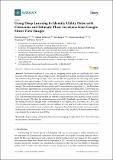Using Deep Learning to Identify Utility Poles with Crossarms and Estimate Their Locations from Google Street View Images
Author(s)
Zhang, Weixing; Witharana, Chandi; Li, Weidong; Zhang, Chuanrong; Li, Xiaojiang; Parent, Jason; ... Show more Show less
Downloadsensors-18-02484.pdf (9.246Mb)
PUBLISHER_CC
Publisher with Creative Commons License
Creative Commons Attribution
Terms of use
Metadata
Show full item recordAbstract
Traditional methods of detecting and mapping utility poles are inefficient and costly because of the demand for visual interpretation with quality data sources or intense field inspection. The advent of deep learning for object detection provides an opportunity for detecting utility poles from side-view optical images. In this study, we proposed using a deep learning-based method for automatically mapping roadside utility poles with crossarms (UPCs) from Google Street View (GSV) images. The method combines the state-of-the-art DL object detection algorithm (i.e., the RetinaNet object detection algorithm) and a modified brute-force-based line-of-bearing (LOB, a LOB stands for the ray towards the location of the target [UPC at here] from the original location of the sensor [GSV mobile platform]) measurement method to estimate the locations of detected roadside UPCs from GSV. Experimental results indicate that: (1) both the average precision (AP) and the overall accuracy (OA) are around 0.78 when the intersection-over-union (IoU) threshold is greater than 0.3, based on the testing of 500 GSV images with a total number of 937 objects; and (2) around 2.6%, 47%, and 79% of estimated locations of utility poles are within 1 m, 5 m, and 10 m buffer zones, respectively, around the referenced locations of utility poles. In general, this study indicates that even in a complex background, most utility poles can be detected with the use of DL, and the LOB measurement method can estimate the locations of most UPCs.
Date issued
2018-07Department
Massachusetts Institute of Technology. Department of Urban Studies and PlanningJournal
Sensors
Publisher
Multidisciplinary Digital Publishing Institute
Citation
Zhang, Weixing, Chandi Witharana, Weidong Li, Chuanrong Zhang, Xiaojiang Li and Jason Parent. "Using Deep Learning to Identify Utility Poles with Crossarms and Estimate Their Locations from Google Street View Images." Sensors 2018, 2484.
Version: Final published version
ISSN
1424-8220